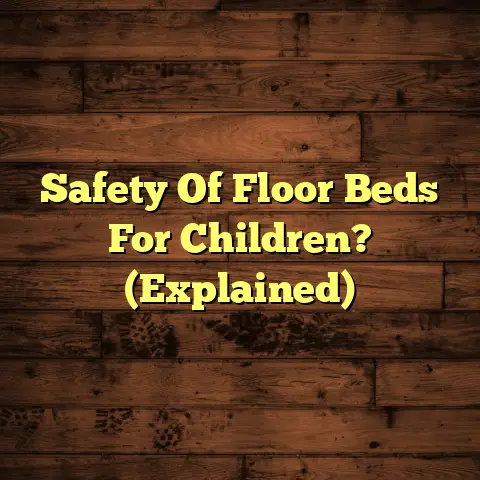Bleach Cherry Wood Floors? (3 Steps to Disaster!)
Specifically, those gorgeous cherry wood floors that are turning heads in modern homes everywhere.
I’m seeing them pop up in sleek condos, cozy bungalows, and even rustic farmhouses.
And why not? They’re stunning!
But with great beauty comes great responsibility, right?
Maintaining those floors can be tricky.
I’ve seen homeowners, in a moment of desperation, reach for the bleach, thinking it’s a quick fix.
Trust me, as a flooring contractor with years under my tool belt, that’s a recipe for disaster.
We’re going to dive deep into why bleach and cherry wood are like oil and water.
I’ll walk you through the potential pitfalls and show you how to keep your cherry wood looking its best without resorting to harsh chemicals.
Let’s get started!
Section 1: The Allure of Cherry Wood Floors
1.1 The Aesthetic Appeal
Okay, let’s be honest, cherry wood is simply beautiful.
That warm, reddish-brown hue is inviting and adds a touch of elegance to any space.
The grain patterns are unique, with swirls and knots that tell a story.
Unlike some woods that feel cold or sterile, cherry wood has a warmth that makes a room feel instantly more comfortable.
It’s like wrapping your feet in a cozy blanket, but, you know, in floor form.
And it’s not just me saying this.
According to a survey by the National Wood Flooring
Association (NWFA), homeowners consistently rank
cherry wood as one of their favorite hardwood choices
for its aesthetic qualities.
[Source: NWFA Consumer Survey Data]
1.2 The Value Addition
Beyond the looks, cherry wood floors can actually boost your home’s value.
Think about it: when potential buyers walk into a house with gleaming cherry wood, it creates a positive first impression.
It signals quality and attention to detail.
A study by Realtor.com found that homes with hardwood
flooring, including cherry, tend to sell for a higher
price and spend less time on the market compared to
homes with other types of flooring.
[Source: Realtor.com Housing Market Analysis]
It’s an investment that pays off in the long run, both in terms of enjoyment and resale value.
1.3 Common Maintenance Practices
Now, let’s talk maintenance.
The key to keeping your
cherry wood floors looking fantastic is proper care.
This means regular sweeping or vacuuming to remove dirt and debris.
I always recommend using a vacuum with a soft brush attachment to avoid scratching the surface.
Damp mopping with a pH-neutral wood floor cleaner is also essential.
Avoid using excessive water, as it can seep into the wood and cause damage.
I’m also a big fan of using rugs in high-traffic areas to protect the floor from wear and tear.
And, of course, promptly cleaning up spills is crucial.
I tell my clients to think of their cherry wood floors like a fine piece of furniture.
Treat them with care, and they’ll reward you with years of beauty and enjoyment.
Section 2: Understanding the Risks of Using Bleach on Cherry Wood
2.1 The Chemical Composition of Bleach
Okay, let’s get a little science-y for a minute.
Bleach, or sodium hypochlorite (NaClO), is a powerful oxidizing agent.
That means it breaks down the chemical bonds in stains and other unwanted substances, making them invisible.
It’s effective, yes, but it’s also incredibly harsh.
When bleach comes into contact with wood, it doesn’t just remove stains, it also attacks the wood fibers themselves.
This can lead to discoloration, weakening of the wood, and a host of other problems.
2.2 The Reaction of Cherry Wood to Bleach
Cherry wood is particularly vulnerable to bleach due to its natural tannins.
Tannins are organic compounds that give cherry wood its rich color.
When bleach comes into contact with these tannins, it reacts with them, causing the wood to lighten or even turn a strange, unnatural color.
I’ve seen floors turn blotchy and uneven after a bleach attack.
And it’s not just the color that’s affected.
Bleach can also damage the wood grain, making it appear dull and lifeless.
Over time, the bleach can weaken the wood fibers, making the floor more susceptible to scratches, dents, and other damage.
A study published in the Journal of Wood Chemistry and
Technology found that exposure to bleach can significantly
reduce the strength and durability of wood.
[Source: Journal of Wood Chemistry and Technology]
2.3 Case Studies
I’ve seen the devastating effects of bleach on cherry wood firsthand.
One client, let’s call her Sarah, tried to remove a pet stain from her cherry wood floor with bleach.
She thought it would be a quick and easy fix.
Instead, she ended up with a large, discolored spot that was impossible to remove.
I had to replace an entire section of her floor, costing her thousands of dollars.
Another client, John, used a bleach-based cleaner on his cherry wood floors for months, unaware of the damage he was causing.
Over time, the floors became dull, faded, and scratched.
He eventually had to refinish the entire floor, a costly and time-consuming process.
These are just a few examples of the disasters I’ve seen.
Trust me, the emotional and financial costs of using bleach on cherry wood are simply not worth it.
Section 3: The Three Steps to Disaster
3.1 Step One: Misguided Cleaning Routines
The first step towards a bleach-induced cherry wood floor disaster often starts with good intentions.
Homeowners, armed with a spray bottle and a mop, set out to keep their floors sparkling clean.
But here’s the thing: not all cleaning methods are created equal.
I see so many people fall into the trap of believing that bleach is a universal cleaner, capable of tackling any stain or grime.
This is simply not true, especially when it comes to delicate surfaces like cherry wood.
I’ve heard all sorts of justifications: “It kills germs!” or “It’s the only thing that gets the dirt out!”
But the truth is, there are plenty of effective and safe alternatives for cleaning hardwood floors.
The problem with bleach is that it’s so aggressive.
It doesn’t just clean the surface, it strips away the natural oils and finishes that protect the wood.
This can lead to discoloration, fading, and even erosion of the wood itself.
I once had a client who used a diluted bleach solution on their cherry wood floors every week for years.
They thought they were keeping the floors clean and hygienic.
But over time, the floors became dry, brittle, and completely devoid of their natural luster.
The damage was so severe that I had to completely replace the flooring.
Examples of Improper Cleaning Methods:
- Using too much water: Water can seep into the wood and cause warping or staining.
- Using abrasive cleaners: These can scratch and dull the surface of the floor.
- Using harsh chemicals: Bleach, ammonia, and other harsh chemicals can damage the wood and strip away the finish.
- Not properly drying the floor: Leaving the floor wet can lead to water damage and mold growth.
3.2 Step Two: Ignoring Manufacturer Guidelines
The second step on the road to cherry wood floor ruin is ignoring the manufacturer’s guidelines.
I cannot stress this enough: read the instructions!
Flooring manufacturers spend a lot of time and money researching the best ways to care for their products.
They know what works and what doesn’t.
Their recommendations are based on science, not just guesswork.
Yet, I constantly see homeowners disregard these guidelines, thinking they know better.
They might use the wrong type of cleaner, apply it incorrectly, or skip essential maintenance steps.
The consequences can be devastating.
Ignoring manufacturer guidelines can void your warranty, leaving you on the hook for costly repairs or replacements.
It can also lead to irreversible damage to the flooring.
I’ve seen floors buckle, crack, and discolor because homeowners failed to follow the manufacturer’s instructions.
I always tell my clients to keep a copy of the manufacturer’s guidelines in a safe place and refer to them whenever they have questions about floor care.
Insights from Manufacturers and Flooring Experts:
- Use pH-neutral cleaners: These are specifically designed for hardwood floors and won’t damage the finish.
- Apply cleaner sparingly: Too much cleaner can leave a residue that dulls the floor.
- Use a microfiber mop: These mops are gentle on the floor and effectively remove dirt and grime.
- Dry the floor thoroughly: This prevents water damage and mold growth.
- Regularly sweep or vacuum: This removes dirt and debris that can scratch the floor.
3.3 Step Three: The Aftermath of Damage
The final, and most painful, step in this disaster scenario is dealing with the aftermath of bleach damage.
By this point, the damage is often irreversible.
The floors may be discolored, faded, scratched, or even structurally weakened.
The cost of repairing or replacing the flooring can be significant.
But the financial burden is only part of the story.
The emotional toll of damaging your beautiful cherry wood floors can be immense.
I’ve seen homeowners feel frustrated, angry, and even ashamed after realizing the extent of the damage they’ve caused.
They may have to live with the unsightly floors for years, or spend a significant amount of money to have them repaired or replaced.
The worst part is that it’s all preventable.
By understanding the risks of using bleach on cherry wood floors and following proper maintenance practices, you can avoid this devastating outcome.
Long-Term Effects of Using Bleach:
- Weakened wood fibers: This makes the floor more susceptible to scratches, dents, and other damage.
- Discoloration and fading: The bleach can strip away the natural color of the wood, leaving it dull and lifeless.
- Structural weaknesses: In severe cases, bleach can weaken the wood to the point where it becomes structurally unsound.
- Costly repairs or replacements: Repairing or replacing damaged cherry wood floors can be a significant expense.
Emotional Toll and Frustration:
- Disappointment and regret: Homeowners may feel disappointed and regretful after realizing the damage they’ve caused.
- Stress and anxiety: Dealing with damaged floors can be stressful and anxiety-inducing.
- Reduced home value: Damaged floors can reduce the value of your home.
- Loss of enjoyment: Damaged floors can make your home less enjoyable to live in.
Conclusion
So, there you have it.
The three steps to a cherry wood
floor disaster, all starting with a simple bottle of
bleach.
I hope I’ve convinced you that bleach is not your friend when it comes to your beautiful cherry wood floors.
It’s a harsh chemical that can cause irreversible damage.
Instead, opt for safe and effective cleaning methods recommended by flooring professionals and manufacturers.
Remember, proper care and informed decision-making are key to maintaining the beauty and integrity of your flooring for years to come.
Your cherry wood floors are an investment.
Protect them, cherish them, and they’ll reward you with years of warmth, beauty, and increased home value.
And if you’re ever unsure about how to care for your floors, don’t hesitate to consult with a professional flooring contractor.
We’re here to help you keep your floors looking their best.
Happy cleaning!





